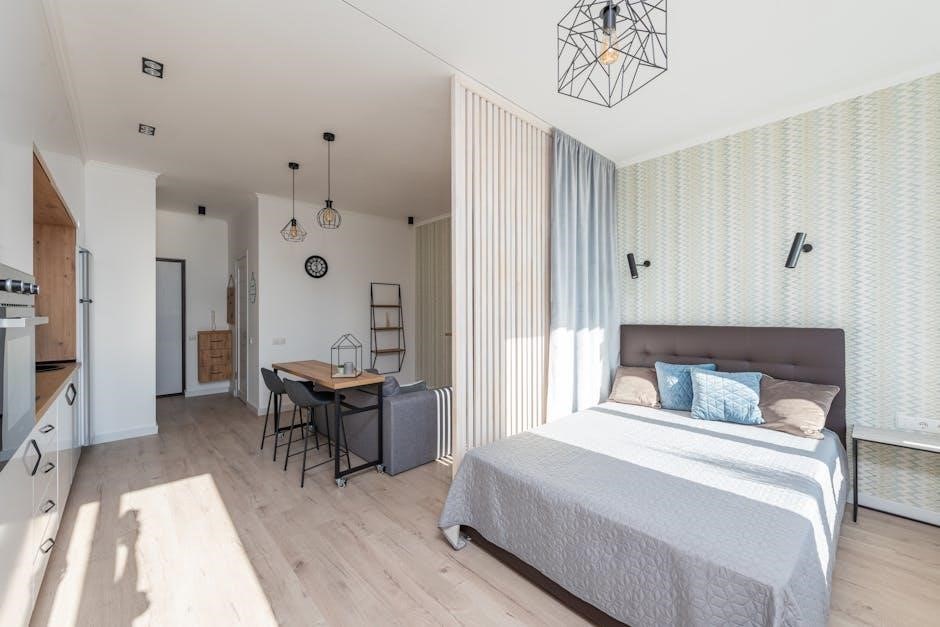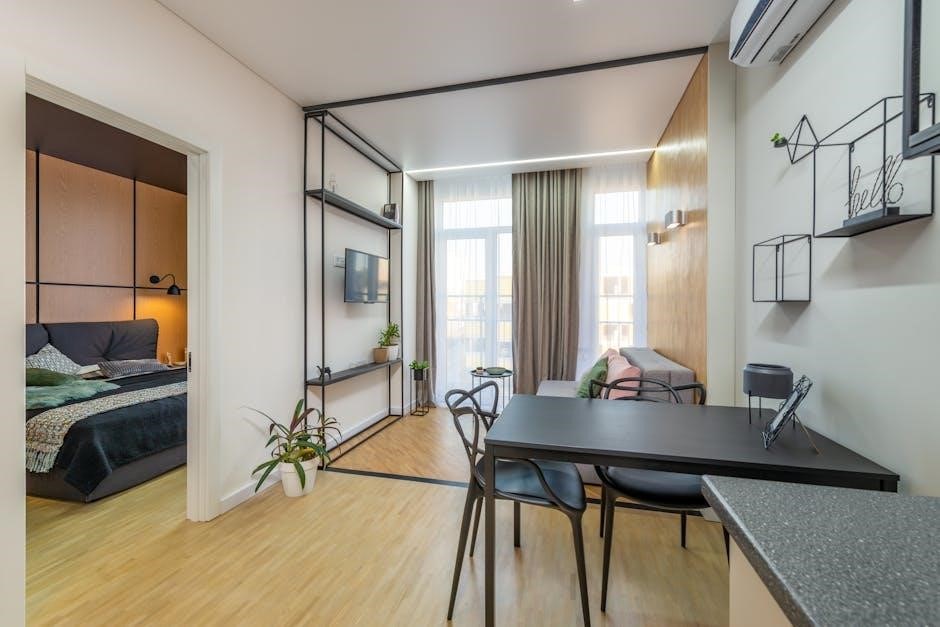A Murphy bed is a space-saving solution that folds into a cabinet or wall, ideal for small rooms. It combines functionality with comfort, offering detailed PDF plans for DIY enthusiasts to build their own. These plans include step-by-step instructions, cutting lists, and hardware requirements, making it easy to create a versatile bed that doubles as a desk or storage unit. Perfect for optimizing space, Murphy beds are a popular choice for modern living.
1.1 What is a Murphy Bed?
A Murphy bed is a space-saving bed that folds into a cabinet or wall, perfect for small rooms. It consists of a bed frame, lift mechanism, and cabinet. The lift mechanism, often a spring or piston system, allows easy opening and closing. This design optimizes space, making it ideal for apartments, guest rooms, or home offices. Detailed PDF plans guide DIY enthusiasts through construction, ensuring a functional and comfortable sleeping solution.
1.2 History and Evolution
The Murphy bed originated in the late 19th century, invented by William Lawrence Murphy to maximize space in small apartments. Initially, it used a simple spring mechanism to fold into a wall. Over time, designs evolved to include cabinets and desks, enhancing functionality. Today, Murphy beds are a staple in modern living, with detailed PDF plans and advanced hardware making DIY construction accessible. This evolution reflects the growing need for space-efficient solutions in urban environments.
Benefits of Murphy Beds
Murphy beds save space, enhance functionality, and boost aesthetics. They fold seamlessly into walls, offering a sleek, modern look while providing storage or desk options, perfect for small spaces.
2.1 Space Efficiency
Murphy beds are renowned for their exceptional space efficiency, folding neatly into walls or cabinets. This design allows rooms to serve multiple purposes, transforming guest rooms into home offices or studios. By eliminating the need for a permanent bed, Murphy beds create open areas for other activities. Their compact mechanism ensures minimal footprint, making them ideal for small apartments, lofts, or rooms with limited square footage. This versatility maximizes living space without compromising comfort or style.
2.2 Multifunctionality
Murphy beds offer exceptional multifunctionality, serving as both a comfortable sleeping solution and a space-saving feature. Many designs incorporate additional elements like built-in desks, shelves, or storage compartments. This versatility allows rooms to function as home offices, guest rooms, or studios, depending on the need. The bed remains fully functional whether folded or in use, making it a practical choice for small spaces. DIY enthusiasts can customize these beds to include features that enhance their daily living needs, ensuring optimal utility in every setup.
2.3 Aesthetic Appeal
Murphy beds are not only functional but also stylish, offering a sleek and modern look that enhances any room’s decor. With various finishes and designs available, they can blend seamlessly into modern or traditional interiors. Some plans even include built-in desks or shelves, adding practicality without compromising style. When folded, the bed creates a clean, open space, making rooms appear larger and more inviting. Detailed PDF plans ensure customization, allowing homeowners to tailor the bed’s design to their aesthetic preferences.
Types of Murphy Beds
Murphy beds come in various styles, including wall-mounted, ceiling-mounted, and horizontal models. Each type offers unique space-saving solutions, catering to different room layouts and design preferences.
3.1 Wall-Mounted Murphy Beds
Wall-mounted Murphy beds are the most common type, folding up against a wall to save space. They are ideal for small apartments or guest rooms. These beds typically use a spring or piston lift mechanism for easy operation. Detailed PDF plans are available, providing step-by-step instructions for assembly and installation. The plans include cutting lists, hardware requirements, and exploded diagrams, ensuring a smooth DIY experience. They are a practical and stylish solution for optimizing space while maintaining comfort.
3.2 Ceiling-Mounted Murphy Beds
Ceiling-mounted Murphy beds are a unique space-saving option, attaching directly to the ceiling rather than the wall. They are less common but offer a sleek, modern look. These beds use a specialized lift mechanism to fold up toward the ceiling, maximizing floor space. PDF plans provide detailed instructions for installation, including hardware requirements and safety considerations. Ideal for rooms with high ceilings, they are a practical choice for optimizing vertical space while maintaining comfort and functionality.
3.3 Horizontal Murphy Beds
Horizontal Murphy beds offer a unique space-saving solution by folding sideways into a wall or cabinet. Unlike vertical models, they are ideal for rooms with lower ceilings. These beds often feature a desk or storage unit, maximizing functionality. PDF plans provide detailed instructions for building horizontal Murphy beds, including measurements and hardware requirements. They are perfect for small apartments or guest rooms, offering a sleek and practical way to optimize space while maintaining comfort and style.
Materials and Tools Needed
Building a Murphy bed requires wood (plywood, MDF, or solid wood), metal components (springs, pistons, hinges), and essential tools like drills, saws, and sanders. Detailed PDF plans outline specific materials and tools needed for a successful project.
4.1 Wood Selection
Choosing the right wood is crucial for a durable Murphy bed. Plywood, MDF, or solid wood are common options, with plywood offering cost-efficiency and solid wood providing strength. Ensure wood is properly sanded and finished to avoid splinters. For a polished look, consider staining or painting. Some plans recommend specific thicknesses for stability. Always check for knots or warping before cutting. Proper wood selection ensures a sturdy and aesthetically pleasing Murphy bed that lasts for years.
4.2 Metal Components
Metal components are essential for the structural integrity and functionality of a Murphy bed. Hinges, springs, and lift mechanisms are critical for smooth operation. Durable materials like steel ensure stability and weight support. Hardware kits often include pre-drilled holes for easy assembly. Proper installation of metal parts is vital for safety and longevity. Choose high-quality components to handle the bed’s weight and ensure reliable performance over time. These elements are crucial for a sturdy and functional Murphy bed design.
4.3 Essential Tools
Building a Murphy bed requires specific tools for accurate assembly. A drill, screwdriver, and wrench are essential for securing hardware. A saw is needed for cutting wood to size. Measuring tools like a tape measure and level ensure proper alignment. Clamps help hold pieces in place during assembly. Sandpaper and a paintbrush may be necessary for finishing. Having all tools ready beforehand streamlines the process and ensures a safe, successful build. Proper tools are key to achieving a professional-grade Murphy bed.
DIY Murphy Bed Plans
Free and paid Murphy Bed Plans are available online, offering step-by-step instructions, materials lists, and hardware requirements. These PDF guides help DIY enthusiasts build functional, space-saving beds easily.
5.1 Free PDF Plans
Free Murphy Bed PDF plans are widely available online, offering detailed step-by-step instructions for DIY enthusiasts. These plans often include materials lists, cutting lists, and exploded diagrams to ensure accurate assembly. Many free plans feature photos and illustrations, making the construction process easier to follow. They cater to various skill levels, providing a cost-effective way to build a space-saving Murphy bed. These plans are ideal for those looking to save money while creating a functional and stylish bed solution.
5.2 Paid Plans and Kits
Paid Murphy bed plans and kits offer premium features for a polished result. These detailed guides include high-quality diagrams, precise cutting lists, and hardware recommendations. Kits often provide pre-cut wood and advanced mechanisms, ensuring professional-grade construction. Paid plans may also include customization options, such as adjustable sizes or stylish finishes. Ideal for DIY enthusiasts seeking precise instructions, these kits deliver a seamless building experience and a durable, long-lasting Murphy bed solution for any room layout or design preference.

Step-by-Step Instructions
Murphy bed plans include detailed guides with visuals, precise measurements, and hardware lists. They walk you through cutting, assembling, and installing, ensuring a sturdy, functional bed that folds seamlessly into the wall.
6.1 Preparation and Planning
Before starting your Murphy bed project, assess the room’s dimensions and layout. Choose materials like plywood or MDF for durability. Select a suitable lift mechanism, either spring or piston-based, to ensure smooth operation. Plan the bed’s orientation and size to fit your space. Gather essential tools like a tape measure, drill, and stud finder. Ensure the wall can support the bed’s weight by checking for studs and obstructions. Review the PDF plans thoroughly to understand each step and prepare a cutting list for accuracy. Safety is key, so double-check all measurements and hardware requirements before beginning construction.
6.2 Assembly Process
Begin by constructing the bed frame using pre-cut wood pieces according to the PDF plans. Attach the lift mechanism, ensuring proper alignment and secure fastening. Assemble the cabinet, attaching hinges and handles for smooth operation. Install the bed frame into the cabinet, connecting all hardware components. Follow the step-by-step instructions to ensure accuracy. Test the mechanism by lifting and lowering the bed to confirm smooth movement. Double-check all bolts and screws for tightness before final installation.
6.3 Installation Tips
Ensure the wall is sturdy and can support the bed’s weight by locating wall studs. Use lag bolts for secure mounting. Double-check the bed is level before final installation. Test the lift mechanism several times to ensure smooth operation. Consider adding handles or grips for easier lowering and raising. For heavy models, consult a professional to avoid structural damage. Follow the PDF guide’s specific instructions for your bed type to guarantee safety and functionality.

Safety Considerations
Ensure proper installation to avoid injuries. Test the lift mechanism thoroughly and verify weight limits. Secure the bed to the wall to prevent tipping. Follow PDF instructions carefully for safe assembly and use.
7.1 Proper Installation Techniques
Proper installation is crucial for safety and functionality. Begin by ensuring the wall is sturdy enough to support the bed’s weight. Use anchor bolts to secure the bed frame firmly to the wall, following the manufacturer’s instructions. Check the lift mechanism for smooth operation and ensure all hinges are tightly fastened. Test the bed by lifting and lowering it several times to confirm stability. Always refer to the provided PDF plans for specific installation steps and guidelines to avoid errors.
7.2 Weight Limits and Load Capacity

Understanding weight limits is essential for safety. Murphy beds typically support between 400 to 1,000 pounds, depending on the model and hardware. Always check the manufacturer’s specifications for the bed’s maximum load capacity. Exceeding this limit can lead to structural failure or collapse. Ensure the bed frame, mattress, and any additional features like storage or desks are within the recommended weight range. Proper installation and adherence to guidelines are critical to maintaining safety and durability.

Customization Options
Murphy beds offer various customization options, including size variations, style choices, and additional features like built-in desks or shelves, allowing users to tailor the bed to their needs.
8.1 Size Variations
Murphy beds are available in various sizes, from twin to king, ensuring they fit diverse spaces and needs. DIY plans often include adjustable dimensions, allowing customization to match room layouts. Whether for a small apartment or a guest room, size variations make Murphy beds versatile. The plans typically provide measurements for different mattress sizes, enabling users to choose the perfect fit. This flexibility ensures the bed blends seamlessly into any setting, maximizing functionality and comfort.
8.2 Style and Design Choices

Murphy beds offer a wide range of style and design options to suit any decor. From modern to rustic, plans often include customizable features like built-in lighting, shelves, or drawers. Users can choose finishes, colors, and materials to match their room’s aesthetic. Some designs incorporate desks or storage units, blending functionality with elegance. Whether traditional or contemporary, Murphy bed plans provide flexibility to create a cohesive look that enhances the space while maintaining practicality and comfort.
8.3 Additional Features
Murphy bed plans often include additional features to enhance functionality and comfort. Built-in lighting, shelves, and drawers provide storage solutions. Some designs incorporate desks or USB ports for convenience. Customizable options like cushioned headboards or ergonomic leg supports are available. Advanced features may include smart technology integration or adjustable mechanisms. These extras allow users to tailor their Murphy bed to meet specific needs, ensuring it serves both practical and aesthetic purposes while maximizing space efficiency and user satisfaction.
Hardware Requirements
Murphy beds require sturdy hardware, including lift mechanisms, hinges, and mounting brackets, to ensure safe and smooth operation. Durable springs or pistons support the bed’s weight effectively.
9.1 Lift Mechanisms
Lift mechanisms are essential for Murphy beds, ensuring smooth and safe operation. Spring-based systems provide reliable support, while piston mechanisms offer effortless lifting. Both options are durable and designed to handle the bed’s weight. Detailed in PDF plans, these mechanisms include exploded views and hardware lists. Proper installation is crucial for functionality and safety. Choose the right mechanism to match your bed’s size and weight for optimal performance and longevity.
9.2 Hinges and Mounting Hardware
Hinges and mounting hardware are critical for the stability and functionality of Murphy beds. Heavy-duty hinges ensure smooth folding and unfolding, while mounting hardware secures the bed to the wall. PDF plans often specify the types of hinges and screws needed, such as specialized lift hinges or sturdy wall brackets. Proper installation of these components is vital for safety and durability, ensuring the bed operates effortlessly for years. Detailed hardware lists in the plans guide DIYers to the right materials.
Construction Guides
Detailed guides provide step-by-step instructions, cutting lists, and diagrams for building Murphy beds. They ensure accurate assembly and proper hardware installation, making the process manageable for DIY enthusiasts.
10.1 Cutting Lists
Cutting lists in Murphy bed plans provide precise measurements for all wood pieces, ensuring accuracy. They detail plywood, solid wood, and hardware requirements, aiding in organized material preparation. These lists, often included in downloadable PDFs, help DIY enthusiasts avoid errors and save time. Detailed diagrams complement the lists, offering visual guidance for complex cuts. By following these, builders can efficiently prepare materials, ensuring a smooth assembly process and professional-grade results. This step is crucial for achieving a sturdy and functional Murphy bed design.
10.2 Detailed Diagrams
Detailed diagrams in Murphy bed plans provide visual guidance, ensuring clarity and precision. These diagrams, often in 3D or exploded views, illustrate component assembly and hardware placement. They complement written instructions, making complex steps easier to understand. Full-color illustrations and exploded views help DIY enthusiasts visualize the process, reducing confusion. Accurate diagrams are essential for achieving a professional finish, ensuring all parts align correctly. They are a cornerstone of successful Murphy bed construction, guiding builders through each stage with precision and clarity.
Common Mistakes to Avoid
Improper installation is a leading cause of Murphy bed failures, often resulting in safety hazards. Neglecting to follow instructions or skipping hardware verification can lead to structural instability. Many builders overlook the importance of precise measurements, causing misalignment issues. Sharp edges on wood can cause injuries, so rounding them is crucial. DIY enthusiasts should also avoid using low-quality materials or incorrect tools, as this compromises durability. Ensuring proper weight capacity and secure mounting is essential to prevent accidents and ensure longevity.

Maintenance and Upkeep
Regular maintenance ensures your Murphy bed remains functional and safe. Check the lift mechanism and hinges for proper alignment and lubricate them periodically. Dust and clean the bed frame and surrounding areas to prevent dust buildup. Inspect hardware for wear and tear, replacing screws or bolts as needed. Ensure the bed is securely closed when not in use to avoid damage. Proper upkeep extends the lifespan of your Murphy bed and maintains its stability and performance over time.
Cost Considerations
Murphy bed plans vary in cost, with free PDF options available for budget-friendly projects. Paid plans offer detailed instructions and diagrams, priced between $20-$100. Materials like wood and hardware add to expenses, depending on the design. DIY kits are another option, ranging from $200-$1,000, depending on size and features. Comparing prices and choosing the right plan ensures a cost-effective solution tailored to your budget and skill level, making Murphy bed construction accessible for various financial situations.

Advanced Features
Advanced Murphy bed plans include features like built-in desks, shelves, and storage compartments. Some designs incorporate lighting or USB ports for added convenience. Premium plans offer adjustable mechanisms for smooth operation and durability. Customization options allow for tailored sizes and finishes, enhancing both functionality and aesthetics. These features cater to modern needs, making Murphy beds versatile and practical for multi-functional spaces, while detailed PDF guides ensure successful implementation of these sophisticated designs.

Troubleshooting
Common issues with Murphy beds include uneven lifting, squeaky hinges, or improper alignment. Ensure all hardware is securely fastened and adjust mechanisms as needed. Lubricate hinges for smoother operation and check weight limits to prevent overloading. If the bed doesn’t fold evenly, inspect the frame and springs for damage. Refer to the PDF plans for specific troubleshooting steps and verify all components are installed correctly to maintain stability and functionality.

Final Tips
When completing your Murphy bed project, ensure all hardware is securely installed and test the mechanism thoroughly. Double-check measurements and alignment for smooth operation. Consider adding a soft-close feature for quieter use. Sand and finish the wood for a polished look. For added convenience, incorporate lighting or shelves in the cabinet. Always follow the PDF plans closely and review instructions before starting. With careful planning and execution, your Murphy bed will be both functional and stylish, enhancing your space efficiently.
Murphy beds offer a practical and stylish solution for space optimization, combining comfort with functionality. With detailed PDF plans available, DIY enthusiasts can easily construct their own, ensuring a perfect fit for any room. These plans provide comprehensive guides, from materials lists to step-by-step instructions, making the process manageable. By following these plans carefully, you can create a Murphy bed that enhances your living space while providing a comfortable sleeping solution. Proper installation ensures safety and longevity, making it a worthwhile project for any homeowner.